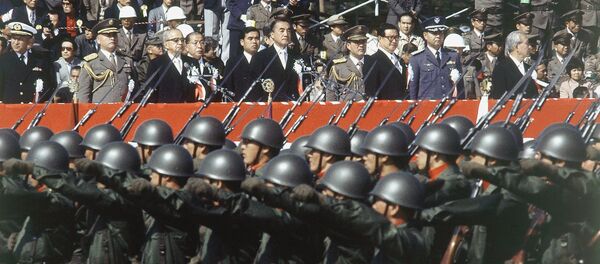The newly announced US-Japanese large-scale naval drills in the Western Pacific is a reminder of America's military prowess, which is addressed to Beijing and Washington's regional allies, Alexei Fenenko, an associate professor at the World Politics Department of Moscow State University, told Sputnik China.
"[US President Donald] Trump has found himself in an embarrassing situation. In May he had repeatedly promised to solve the Democratic People's Republic of Korea's (DPRK) nuclear issue, but nothing has been done yet. [On the other hand] he didn't dare to use force. Naturally, questions have been raised among [American] allies whether the US is really strong and concerns emerged whether [the Americans] are still committed to their obligations," Fenenko elaborated.
Reuters reported Tuesday that three US aircraft carrier strike groups, including the USS Nimitz, the Ronald Reagan, the Theodore Roosevelt and their accompanying warships, would exercise together in the region for the first time in a decade amid Trump's Asian tour. The media outlet added that a Japanese destroyer, the Inazuma, would join the drills.
While Trump is demonstrating strength, there is every indication that China will not respond to the show of force in the same way, the Russian academic underscored.
"China is not a warmongering nation," Fenenko said. "China has always pursued a peaceful strategy to increase its influence. That is why China will not respond [to the recent drills] militarily."
According to the academic, Beijing is more likely to increase cooperation with the ASEAN. He highlighted that US' military activities in the region usually prompt serious concerns and irritation among Southeast Asian nations.

Yang Mian, a political analyst at the Center for International Relations at the Chinese Institute of Communications, focused attention on the fact that India is among the nations holding military exercises during Trump's Asian tour.
"Trump has already clearly formulated the Indo-Pacific strategy," Yang told Sputnik. "It differs from Barack Obama's strategy aimed at restoring the balance of power in the Asian-Pacific region. Trump's strategy envisages the need to preserve the US dominance in the Indo-Pacific region, to strengthen the US-Indian alliance."
"India's influence is constantly growing, at the same time it is involved in a territorial dispute with China," Yang continued. "The 'Abe Doctrine' is also designed to counter China's growing influence. On the eve of the APEC meeting and the ASEAN summit, three American aircraft carriers accompany the US leader during his visits to Japan, South Korea, China, Vietnam and the Philippines."
The Chinese analyst emphasized that the naval maneuvers are targeting North Korea: They are warning Pyongyang against conducting a nuclear or missile test during Trump's 12-day visit to the Asia-Pacific region.
However, in the long run Washington's joint naval exercises with Japan and India send a message to Beijing that US-Indian ties are strengthening, while the three remain important players in the region.
Meanwhile, in response to the reports about joint military drills involving three US aircraft carriers the Chinese Foreign Ministry warned against aggravating tensions on the Korean Peninsula and called upon all the parties to show restraint and make active efforts to solve the North Korean issue through negotiations.
At the same time, Beijing is looking forward to Trump's three-day state visit, considering it to be of significant importance.
"The upcoming visit of President Trump to China will definitely have a historic success," Chinese Foreign Ministry spokeswoman Hua Chunying said during a press briefing.
On Tuesday, the United States, South Korea and Australia finished navy drills, which were "aimed at the prevention of import and export of North Korean nuclear weapons and other weapons of mass destruction, and at the implementation of UN Security Council resolutions regarding illicit and provocative actions of North Korea."
In mid-October, the US and South Korea conducted joint exercises in the Japanese and the Yellow Seas. The drills involved 40 ships, including US nuclear aircraft carrier Ronald Reagan.






